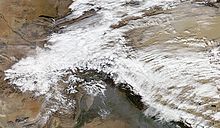This article needs additional citations for verification. (May 2016) |

A western disturbance is an extratropical storm originating in the Mediterranean region that brings sudden winter rain to the northwestern parts of the Indian subcontinent,[1][2] which extends as east as up to northern parts of Bangladesh and South eastern Nepal.[3] It is a non-monsoonal precipitation pattern driven by the westerlies. The moisture in these storms usually originates over the Mediterranean Sea, the Caspian Sea and the Black Sea.[4][5] Extratropical storms are a global phenomena with moisture usually carried in the upper atmosphere, unlike their tropical counterparts where the moisture is carried in the lower atmosphere. In the case of the Indian subcontinent, moisture is sometimes shed as rain when the storm system encounters the Himalayas. Western disturbances are more frequent and stronger in the winter season.[6]
Western disturbances are important for the development of the Rabi crop, which includes the locally important staple wheat.[7][8]
- ^ J. S. Lall, A. D. Modd (1981), The Himalaya, aspects of change, India International Centre, ISBN 978-0-19-561254-7,
... The onset of a western disturbance is heralded by dense thunder clouds accompanied by heavy rain or snow. The weather conditions during winter are generally influenced by the distribution pattern of pressure in Central and West Asia. In winter, due to the shifting of the pressure belts, the westerlies blow from 20°N to 50°N latitude and Northern India comes under the influence of the winds and cyclones rising from the Mediterranean Sea. In the wake of the disturbance comes cold air and often accompanied by strong winds ...
- ^ D. K. Majumdar (2004). Irrigation water management: principles and practice. PHI Learning Pvt. Ltd. ISBN 978-81-203-1729-1.
... Rains during winter mont in north India are due to occurrence of low pressure system called western disturbances. This moves from the west to the east causing snow fall in the high ranges in the Himalayas and rains in sub-mountainous tracts and adjoining areas ...
- ^ Faridi, Rashid (2013-02-24). "Western Disturbance in India, Pakistan, Bangladesh and Nepal". Rashid's Blog: An Educational Portal. Retrieved 2021-07-07.
- ^ "Experimental Agrometeorology: A Practical Manual," Latief Ahmad, Raihana Habib Kanth, Sabah Parvaze and Syed Sheraz Mahdi, Page 142, Springer International Publishing, 2017, ISBN 9783319691855, "Western disturbances noticed as cyclonic circulation/trough in the mid and lower tropospheric levels or as a low-pressure area on the surface, which occur in middle latitude westerlies and originate over the Mediterranean Sea, Caspian Sea and Black Sea and move eastwards across north India"
- ^ Dimri, A.P.; Chevuturi, Amulya (9 February 2016). Western Disturbances – An Indian Meteorological Perspective. Springer. pp. 5, 6, 7. ISBN 978-3319267371. Retrieved 23 May 2016.
- ^ Hunt, Kieran M. R.; Turner, Andrew G.; Shaffrey, Len C. (2017-11-11). "The evolution, seasonality and impacts of western disturbances" (PDF). Quarterly Journal of the Royal Meteorological Society. 144 (710): 278–290. doi:10.1002/qj.3200.
- ^ Social Science (A Textbook in Geography Part II) Class X. FK Publications.
... These states are: Punjab, Haryana, Himachal Pradesh, Jammu & Kashmir, Uttarakhand and Uttar Pradesh. These states receive some rainfall (precipitation) during the rabi season, brought about by western disturbances, which originate in the Mediterranean region. These showers are very beneficial for rabi crops ...
- ^ J.E. Parkinson, R. H. Whitehouse (1927). Proceedings. Printed at the Mufid-i-'Am Press.
... In northern India rainfall occurs again during the year in connection with the Western Disturbances which are of great agricultural importance to north-west India as they occur chiefly during the Rabi ...